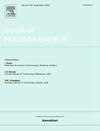机器学习在核电厂管道检查中的应用:方法、数据和未来趋势的回顾
IF 2.3
3区 工程技术
Q1 NUCLEAR SCIENCE & TECHNOLOGY
引用次数: 0
摘要
管道安全是核电站的一个重要问题,对管道故障的不准确预测将导致经济损失和致命事故。传统的检测方法过于费力和昂贵,并且需要专业知识。机器学习(ML)模型可以从可用数据中学习,并用于核管道安全。一项全面的文献检索显示,没有现有的评论专门关注核电厂(NPPs)中使用ML的管道安全。考虑到这一点,已作出努力对这一专题进行全面审查。通过调查目前使用ML进行的核电厂管道系统腐蚀安全性研究,本文揭示了主要的研究差距。本文回顾了各种ML模型和数据集。其中卷积神经网络、支持向量机和人工神经网络是发展最为广泛的模型。基于振动的数据集在机器学习应用中被广泛用于分析管道退化,因为它们可以有效地捕获结构健康变化,预测故障、管道退化严重程度、管壁减薄率、流动加速腐蚀率和管弯头减薄率。尽管在可用数据上成功实现了ML模型,但主要的限制包括数据稀缺(由于运行检查或模拟所需的成本和劳动力)和有限的场景(受限制的操作条件和管道几何形状)。此外,还讨论了未来的建议,如应用合成少数过采样技术、生成对抗神经网络、迁移学习和物理信息ML,以改善ML在核电厂管道系统中的应用。本文章由计算机程序翻译,如有差异,请以英文原文为准。
Machine learning applications in nuclear power plant piping inspection: A review of methods, data, and future trends
Piping safety is an important concern in nuclear power plants, where an inaccurate prediction of pipe failure will lead to financial loss and fatal incidents. Traditional inspection methods are too laborious and costly, and require expert knowledge. Machine learning (ML) models can learn from the available data and be used for nuclear piping safety. A comprehensive literature search reveals that no existing review has focused exclusively on piping safety using ML in nuclear power plants (NPPs). Keeping this in view, efforts have been made to provide a comprehensive review of this topic. The review reveals the main research gaps by investigating the current studies conducted for the safety of NPP piping systems subjected to corrosion using ML. Various ML models and datasets have been reviewed in this review article. It was observed that convolutional neural network, support vector machine, and artificial neural network are the most widely developed models. Vibration-based datasets have been extensively utilized in ML applications for analyzing pipe degradation due to their effectiveness in capturing structural health changes and predicting failures, pipe degradation severity, pipe wall thinning rate, flow accelerated corrosion rate, and pipe elbow thinning rate. Despite the successful implementation of the ML models on available data, major limitations include data scarcity (due to cost and labor required to run the inspections or simulations) and limited scenarios (restricted operating conditions and geometries of piping). In addition, future recommendations such as applying synthetic minority oversampling technique, generative adversarial neural network, transfer learning, and physics-informed ML are discussed to improve the ML application for NPP piping systems.
求助全文
通过发布文献求助,成功后即可免费获取论文全文。
去求助
来源期刊

Annals of Nuclear Energy
工程技术-核科学技术
CiteScore
4.30
自引率
21.10%
发文量
632
审稿时长
7.3 months
期刊介绍:
Annals of Nuclear Energy provides an international medium for the communication of original research, ideas and developments in all areas of the field of nuclear energy science and technology. Its scope embraces nuclear fuel reserves, fuel cycles and cost, materials, processing, system and component technology (fission only), design and optimization, direct conversion of nuclear energy sources, environmental control, reactor physics, heat transfer and fluid dynamics, structural analysis, fuel management, future developments, nuclear fuel and safety, nuclear aerosol, neutron physics, computer technology (both software and hardware), risk assessment, radioactive waste disposal and reactor thermal hydraulics. Papers submitted to Annals need to demonstrate a clear link to nuclear power generation/nuclear engineering. Papers which deal with pure nuclear physics, pure health physics, imaging, or attenuation and shielding properties of concretes and various geological materials are not within the scope of the journal. Also, papers that deal with policy or economics are not within the scope of the journal.
 求助内容:
求助内容: 应助结果提醒方式:
应助结果提醒方式:


